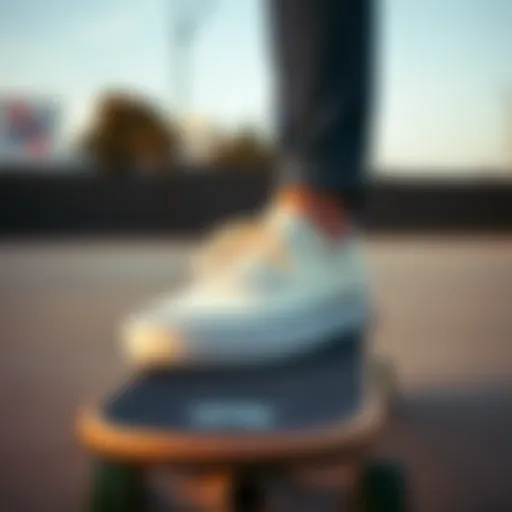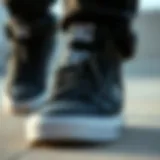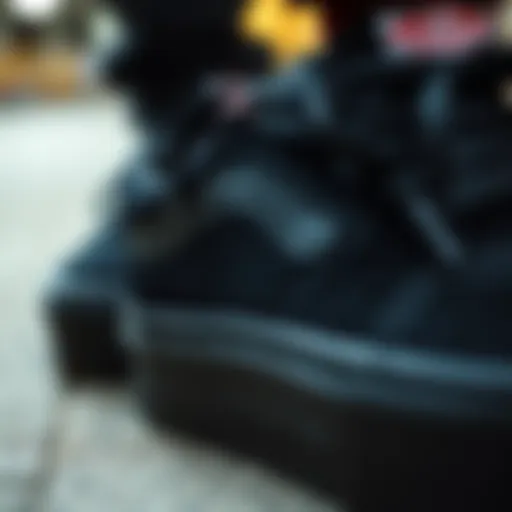Understanding Surf Skate Trucks: Design and Performance


Intro
Skateboarding has always had its roots in culture and creativity, melding elements from various disciplines into a unique and exhilarating experience. Among the vast array of skateboarding gear, surf skate trucks stand out due to their distinctive design and functionality, offering riders an experience akin to surfing on pavement. These trucks, which allow for sharper turns and dynamic movements, cater to a wide variety of skateboarding styles—making them essential for enthusiasts wanting to enhance their riding. Understanding the mechanics behind surf skate trucks can unlock a new realm of tricks, maneuvers, and overall performance.
In this article, we’ll be diving deep into the world of surf skate trucks, exploring their design intricacies, and analyzing their impact on performance. We'll categorize different types of trucks, examine the materials and technology that come into play during construction, and discuss how each component influences maneuverability, stability, and responsiveness. Additionally, we'll share maintenance tips, ensuring that your gear performs at its best, and provide guidance on selecting the right trucks based on your unique style as a skateboarder.
By grasping the nuances associated with surf skate trucks, skaters can make well-informed decisions that will not only enhance their skills but also elevate their enjoyment of skateboarding as a whole. Let's hit the ground running and explore the tricks and techniques that make surf skate trucks a favorite among riders around the globe.
Understanding Surf Skate Trucks
To truly appreciate the world of surf skating, one must first grasp the significance of surf skate trucks. They are not merely a component of skateboards; they're the crucial link between the rider and the board, shaping everything from speed to maneuverability. Understanding these trucks is vital for skaters, as it influences riding style and the overall experience on the board.
One of the primary benefits of comprehending surf skate trucks lies in the improved performance it affords. With knowledge of how different components function, a rider can select the right truck to suit their style, whether it be for carving, tricking, or simply cruising. This selection can make all the difference when you're zipping down the street or flowing through a park.
Moreover, by delving into the design and mechanics of these trucks, skaters are better equipped to identify maintenance needs and implement adjustments that enhance their ride. A well-maintained truck can significantly improve stability, while improper care can lead to instability and unpredictable rides.
In this exploration, we’ll demystify the parts that make up surf skate trucks and how they contribute to the art of skateboarding. Readers will come to understand the nuances of surf skate technology through historical context, design elements, and functionality. Ultimately, this comprehension not only enriches the riding experience but also fosters a connection with the heritage of skateboarding itself.
What are Surf Skate Trucks?
At their core, surf skate trucks are specialized components designed to replicate the fluid movements of surfing while on land. Unlike traditional skateboard trucks, surf skate trucks are engineered with a unique pivot point that allows for more exaggerated turning and carving, emulating the dynamics of wave riding.
These trucks typically feature a mechanism that permits lateral movement and flexibility, resulting in an experience that feels more like surfing than skating. Riders can lean into turns, much like they would on a wave, providing an exhilarating feeling that may bring to mind the surf scene.
In essence, surf skate trucks serve as the backbone for anyone looking to embrace the surfing vibes while utilizing a skateboard. They provide not just stability, but a sense of rhythm and flow that is unparalleled in traditional skateboarding setups.
History of Surf Skate Trucks
The history of surf skate trucks is as colorful as the sport itself. It can be traced back to the 1970s when surfing culture began spilling onto the streets with skateboards in tow. Initially, riders were using regular skateboard trucks, but it soon became clear that adjustments were necessary to better mimic the movements found in surfing.
Early innovators started modifying traditional trucks, adding wheels that allowed for a greater range of motion. This evolution led to the development of the first purpose-built surf skate trucks. Pioneers like the Z-Boys of Santa Monica played a vital role in pushing this concept forward. They designed equipment that would handle the rigors of their unique, flowing style.
As skateboarding grew, so too did the technology surrounding it. Over the decades, surf skate trucks have undergone numerous iterations, adapting to the changing demands of skaters. From varying angles of the kingpin to innovative bushing designs, the focus has shifted continuously towards enhancing the rider's experience.
Today, surf skate trucks come in various forms, each boasting different design features that cater to specific riding styles. Understanding this history not only provides context but also highlights the ingenuity and creativity behind the surfing-skateboard crossover culture.
Design Elements of Surf Skate Trucks
Understanding the design elements of surf skate trucks is crucial for skaters who want to enhance their riding experience and optimize their technique. Each component plays a distinct role in determining how a board performs under different conditions. From bending and turning to overall stability, these design elements have direct implications on how effectively a rider can maneuver. By examining these elements, you'll grasp not just how your truck functions, but how adjustments can align better with your individual style.
Key Components
Baseplate
The baseplate is the foundation of the surf skate truck and serves more than just a mounting point. Made typically from robust materials, it is what connects the truck to the skateboard deck. A significant aspect of the baseplate is its design, which can be either low or high, affecting your center of gravity and how you interact with the board.
A lower baseplate will grant better stability for tricks, while a higher version may allow for deeper turns. One unique feature of some baseplates is the inclusion of angle adjustability, enabling riders to customize their setup for different riding styles. Sometimes, however, it comes at the expense of weight. This flexibility often makes a strong case for its place in surf skate culture.
Hanger
The hanger is another vital element that directly contributes to how a board behaves. This component plays an essential role in the turning capabilities of the skateboard. A narrow hanger could allow for sharper turns but may sacrifice stability at high speeds; conversely, a wider hanger supports higher levels of stability while sacrificing some agility.
Noteworthy manufacturers often focus on improving the material and shape of the hanger to optimize responsiveness. Some might find a particularly agile hanger to be a blessing when making quick turns, but this may present challenges when performing tricks .
Axle
The axle is crucial to the overall functionality. Besides providing the grip for the wheels, its length determines how far apart the wheels are set. A longer axle creates a wider stance, providing better balance for certain riding styles, crucial for maintaining control during complex maneuvers.
When it comes to durability, axles made from high-quality steel often offer excellent longevity. However, they sometimes incur a tradeoff in weight, which can slightly impact performance for lightweight riders. With these considerations in mind, choosing an axle that suits your style becomes imperative.
Bushings


Bushings are like the unsung heroes of the surf skate truck system. These rubber-like components act as cushions for the movements, absorbing shocks from landings and providing the rider with the right level of flex. They come in varying hardness levels, allowing riders to set their preference for how responsive or stiff they want their ride to feel.
While softer bushings enable smoother turns, they can also lead to increased instability when riding at high speeds. Conversely, harder ones provide stability but might not be as forgiving during maneuvers. Finding the right bushing can greatly change the comfort and responsiveness of the board, making this a critical decision.
Materials Used
Aluminum
Aluminum has emerged as a popular material choice in crafting surf skate trucks due to its excellent balance between lightness and strength. This allows riders to experience agile turns without significantly sacrificing durability. Many skaters prefer aluminum trucks due to their resistance against rust and wear, making them ideal for both urban settings or coastal regions. However, one downside to aluminum is the potential for bending under high impacts, pushing some skaters towards beefier options for more robust performance.
Steel
When it comes to strength, steel often leads the pack. Trucks made from steel boast unparalleled durability and can withstand harsher abuses. For skaters who push boundaries, particularly in street skating, steel trucks can serve as a reliable option. The tradeoff is that steel is heavier than other materials, which can affect performance. Thus, it is often preferred by those who prioritize performance over speed.
Composite Materials
Composite materials offer an exciting alternative in modern truck production. They are designed to encapsulate the benefits of both aluminum and steel, providing a light yet strong option. Notable is their resistance to corrosion and wear, giving composite trucks a longer lifespan in diverse environments.
The unique feature here is how these materials can be molded into various shapes, impacting the truck’s weight and aerodynamics. However, skaters note that while composites excel in durability, they sometimes miss the raw feel that metal trucks provide in terms of board control and feedback.
By understanding the specific elements of surf skate trucks, from their components and materials to their impact on rider experience, enthusiasts can make informed choices that enhance their skateboarding adventures. The right truck can fundamentally shift one’s confidence and enjoyment, marking the difference between an average session and a truly memorable ride.
Functionality and Maneuverability
Understanding the functionality and maneuverability of surf skate trucks is fundamental for any skater aiming to refine their riding style. The way these trucks are designed significantly influences how a skateboard responds to the rider's movements, allowing for a range of styles, from relaxed cruising to high-speed carving. Choosing the right truck can mean the difference between feeling balanced and in control, or awkward and unsteady.
Turning Radius
The turning radius of a surf skate truck determines how sharply a rider can turn while maintaining speed and stability. This characteristic is particularly crucial for skaters looking to mimic the feeling of surfing while on land. A tighter turning radius offers the ability to navigate sharp corners effortlessly, allowing for a more fluid and dynamic experience. Conversely, a wider turning radius tends to lend itself better to stability at higher speeds, providing a comfortable ride during longer sessions.
Factors that contribute to the turning radius include the design of the hanger and the flexibility of bushings, which combine to provide a unique responsiveness. For instance, trucks that feature a more extended hanger tend to have a more expansive turning radius, making it easier for skaters to carve smoothly. It's important to note that while tighter turns can be enticing, they often come at the cost of stability, especially for beginners still finding their balance on the board. Looking at the specifics:
- Tight turning radius: Great for tricks and sharp maneuvers. Ideal for skaters who enjoy aggressive riding.
- Wider turning radius: Better for maintaining speed and stability. It suits skaters who value control and a comfortable ride.
Flexibility vs. Stability
Striking the right balance between flexibility and stability is essential for skaters to achieve their desired riding style. Flexible trucks allow for a more responsive feel, making it easier to initiate turns and adjust body weight during maneuvers. This quality resonates well with skaters who thrive on creativity and precision in their tricks. However, too much flexibility can lead to what some skaters refer to as "wobbly" feelings, especially at high speeds.
On the flip side, stability becomes paramount during fast rides and tricks. Solidly built trucks enhance the skater's ability to maintain control, especially during aggressive movements or when taking on steep ramps. Skaters invested in executing aerials or complex tricks may prefer heavier-duty trucks with less flex, providing a firm foundation underfoot.
When deciding between flexibility and stability, consider:
- Your riding style: Are you focused on tricks and agility or cruising and speed?
- Your experience level: Beginners might benefit more from stable setups, while advanced skaters could explore flexible options for creativity.
Each choice carries weight, affecting not only performance but also comfort on the board.
"In surf skating, balance is key. Too much of one element can throw your whole game off. Understand what your style demands and select accordingly."
Ultimately, the functionality of trucks goes hand in hand with the maneuverability they provide. Being aware of how turning radius, flexibility, and stability play into your specific skating needs can dramatically enhance your overall experience. As you experiment and find your sweet spot, you'll be able to embrace the true essence of surf skating, paving the way for fluid rides and exciting adventures.
Types of Surf Skate Trucks
Understanding the various types of surf skate trucks is essential for skaters eager to find their perfect fit. These trucks serve not only as pivotal components but also profoundly affect the overall riding experience. Each type offers distinct benefits and challenges, making this knowledge crucial for both novices and seasoned riders alike. Having familiarity with these categories can lead to improved performance, enhanced maneuverability, and ultimately, greater enjoyment on the board.
Traditional Surf Skate Trucks
Traditional surf skate trucks are the foundation of many standard skateboards. These trucks generally have a more rigid design, providing a firm connection to the deck. Unlike their more sophisticated counterparts, the simplicity of traditional trucks fosters ease of use, making them ideal for those who are just starting or prefer a straightforward ride.
- Advantages:
- Stability at high speeds
- Less maintenance required
- Reliable performance for tricks and turns
However, they lack the flexibility seen in other types of surf skate trucks. This rigidity can limit the ability to carve deeply and achieve that surf-like feeling which many riders crave. Thus, choosing traditional trucks often comes down to preference and the desired riding style.


Spring Loaded Trucks
Spring loaded trucks add an exciting twist to the standard setup. These trucks incorporate springs that allow for a more fluid motion while turning, mimicking the feeling of surfing on water. Skaters who thrive on fluid dynamics and sharp turns may find these trucks appealing. The ability to bounce back after a turn or carve sharply can elevate the riding experience to new dimensions.
- Benefits:
- Exceptional responsiveness in carving
- Enhanced stability when turning
- Mimics the feel of surfing on waves
Nevertheless, potential downsides exist. The additional complexity of spring loaded trucks means they may require more maintenance and occasional tune-ups. Riding in a variety of conditions can also affect their performance, requiring riders to adjust their technique accordingly.
Adjustable Trucks
Adjustable trucks represent a modern solution for skaters who want customization. Riders can modify the tension and height of the trucks to fit their personal style and preferences. This adaptability allows for a unique blend of stability and flexibility, catering to various riding conditions and techniques.
- Features:
- Easy adjustments for differing styles
- Versatile performance to suit various terrains
- Potential for improved trick execution
However, this flexibility comes with its own set of challenges. Skaters might need to invest extra time to find the right settings for their riding preferences. Moreover, if adjustments aren’t made correctly, it can lead to a less-than-ideal skating experience, impacting performance in both tricks and maneuvers.
Impact on Riding Style
The relationship between surf skate trucks and riding style is a fascinating one. Understanding how different trucks affect the way you ride is essential for any skater looking to refine their technique. Surf skate trucks are not just a mere accessory; they are pivotal in dictating how you interact with the board. From turning radii to stability, the configuration of your trucks can either enhance or hinder your performance.
Skaters often find themselves adjusting their riding technique based on the type of trucks they use. For instance, those with a penchant for traditional surf skate trucks might notice a smoother, more flowing ride, imitating the sensations of surfing on land. This style is often characterized by wide, sweeping turns and fluid movements. On the other hand, those who opt for more aggressive setups, like spring-loaded trucks, may experience a far more responsive ride, influencing their riding technique fundamentally.
Adjusting Your Technique
Adjusting your technique comes hand in hand with knowing your surf skate trucks. Different trucks have their unique characteristics that can change how a skater approaches the board. For instance, skaters using adjustable trucks can tinker with the stiffness or flexibility to better suit their style. Some might prefer to take a laid-back approach with tighter turns and slower speeds, while others may thrive on the thrill of quick bursts and sharp angles.
- Weight Distribution: Understanding your weight distribution is crucial. If you’re riding traditional trucks, a more forward stance might be ideal for deep carves.
- Body Position: Shifting your body position slightly can help in leaning into turns, increasing control and confidence.
- Foot Placement: Experimenting with various foot placements can drastically shift your riding style. Depending on the truck configuration, moving your feet forward can enhance your ability to pump and gain speed.
The key takeaway here is to find what works for you. The best way to experiment is to take time on different boards, adjusting your technique as you go. Not every skater rides in the same way, so be sure to log your experiences!
Influence on Tricks and Maneuvers
The choice of surf skate trucks can significantly impact the tricks and maneuvers a skater is capable of executing. For example, if you’re into doing slides or sharp turns, shorter trucks might be more suitable. These allow for greater responsiveness and enable a skater to execute tricks with precision.
- Tricks like Kickflips: Trucks that are too loose may interfere with balance during landings. It’s important to find a balance so you don’t end up wobbling all over the place.
- Carving and Pumping: For those who love to carve, surf skate trucks feel right at home. The design allows for an exaggerated carving motion, similar to turns one might take on a wave.
- Stability for Jumping: When it comes to jumping, stability is key. Trucks that inspire confidence allow skaters to be brave when attempting more advanced moves.
Understanding how surf skate trucks influence your ability to perform tricks can mean the difference between landing that difficult maneuver or wiping out.
In summary, knowing how your surf skate trucks impact your riding style leads to improved performance on the board. As you tailor your technique, you’ll find that the right trucks can inspire creativity and confidence in your skating.
Maintenance and Care
The longevity and performance of surf skate trucks hinge heavily on regular maintenance and care. Neglecting to tend to the trucks may lead to diminished performance, reduced safety, and potentially more costly repairs down the line. A proactive approach not only keeps your gear in peak condition but also enhances the overall experience of riding. From checking for signs of wear to ensuring the right level of lubrication, a diligent maintenance routine is essential for any dedicated skater.
Routine Inspections
Routine inspections act as the first line of defense in the maintenance strategy for surf skate trucks. These checks should be conducted frequently, ideally after every few rides or at least once a week, depending on usage.
- What to Look For:
- Baseplate Integrity: Make sure there are no cracks or distortions. A compromised baseplate can affect your stability while riding.
- Bushings: These should be inspected for wear or cracking. Good bushings allow for smooth turns and maintain responsive steering. If they're stiff or split, it's time for a replacement.
- Axle Condition: Look for rust or damage on the axle. Affected axles can lead to wheel distortion or locked bearings.
- Hanger Movement: Ensure the hanger moves freely without obstruction. Restricted motions could lead to difficult turning and reduced maneuverability.
Regular inspections can help catch potential issues early, allowing for timely intervention. This vigilance pays off in improved performance and safety on the board.
Lubrication Practices
Proper lubrication is another cornerstone of surf skate truck maintenance. It contributes to smoother performance and extends the life of your trucks. Keeping moving parts well-lubricated reduces friction and prevents wear and tear from setting in.
- Recommended Practices:


- Choosing the Right Lubricant: Use high-quality greases specifically designed for skateboards. Avoid motor oils or any products that can cause buildup or attract dirt.
- Application Points: Focus on bushings and areas where the axle meets the truck. This is where friction typically accumulates.
- Frequency of Lubrication: Depending on usage, a good rule of thumb is to lubricate every few weeks or after riding in wet conditions. If you notice a squeaking sound, it might be time to apply some lubricant.
"A little maintenance goes a long way. Keep your gear in check, and it will reward you with smooth rides."
Choosing the Right Surf Skate Truck
Selecting the right surf skate truck is pivotal for skaters, whether they're just starting out or are seasoned pros looking to improve their performance. The variances in truck designs can significantly alter one's riding experience, affecting everything from stability to turning capabilities. Picking the right one is not just a matter of brand loyalty; it requires understanding your skating style, the type of boards you prefer, and how you want to move on your board.
When you delve into surf skate trucks, consider the following key elements:
- Riding Style: The way you ride will dictate which truck style suits you best. Are you into tight turns or smooth carving? These preferences will help steer your choice.
- Weight: Trucks come in different weights, which can affect how easily you maneuver. Heavier trucks offer more stability, but they can be cumbersome for tricks.
- Width: The width of the truck should correspond with the width of your board. A mismatch here can lead to an awkward riding experience.
In essence, the right surf skate truck will complement not just your board, but also your individual preferences and skills. Opting wisely can make the difference between a good ride and a great one.
Considerations for Beginners
For those new to skateboarding, the sheer number of options can be daunting. Many beginners may not fully grasp what makes a good surf skate truck, but a few considerations can help narrow the field.
- Learn the Basics: Before diving deep into specific features, it’s crucial to get a feel for the basics. New skaters should ideally choose trucks that offer a balance between maneuverability and stability. This means opting for a size that matches their board and one that allows them to practice turns comfortably.
- Adjustability: Some brands offer adjustable trucks. For beginners, this can be a boon, allowing them to tweak the setups based on their comfort and progress.
- Budget: Not every beginner wants to splash out on the premium kits. However, it is wise to invest a bit more for durability, as cheaper options may not hold up well under heavy use.
- Community Recommendations: Engaging with local skate communities can offer real-world insights. Fellow skaters can provide valuable feedback and recommendations based on their own experiences.
By focusing on these aspects, newcomers will set themselves up for success, ensuring their initial rides don't create bad habits or discouragements.
Advanced Skater Preferences
Once the basics are mastered, advanced skaters often have a different set of priorities when it comes to choosing surf skate trucks. Their experience shapes distinct preferences:
- Precision: Seasoned skaters tend to lean towards trucks that offer enhanced precision. They often appreciate brands that engineer systems designed for speed and responsiveness. This means a keen eye on the bushings and pivot systems.
- Flexibility: Advanced riders often prefer trucks that can handle aggressive pumping and carving. Flexibility plays a crucial role here, allowing for more dynamic movements that emulate surfing.
- Personalization: Custom setups become commonplace. Many experienced skaters will mix and match components to suit their individual styles. This could include swapping bushings or even modifying the truck geometry for more tailored performance.
- High-Performance Materials: The materials used in construction take on greater importance at this level. Trucks made from lighter, stronger metals or composites are often favored as they enhance performance without sacrificing durability.
For advanced skaters, the right surf skate truck doesn’t just meet needs; it enhances their entire skate experience, allowing them to express their personality through their riding techniques.
"Finding the right setup isn’t just about the truck; it’s about how it feels under your feet when you carve, pump, and fly."
Future Trends in Surf Skate Trucks
As surf skate culture continues to evolve, the technology and materials used in surf skate trucks are also undergoing significant changes. Staying abreast of these trends is essential not only for manufacturers but also for enthusiasts and skaters alike. Understanding these advancements can enhance performance and ride quality, making a marked difference in an individual’s skating style and enjoyment.
Emerging Technologies
One of the most notable trends is the integration of advanced technologies into surf skate truck designs. Manufacturers are increasingly experimenting with smart tech, aiming to augment the skater's experience. For instance, some new trucks are equipped with sensors that measure maneuverability, tilt angles, or even energy distribution. These analyses can provide invaluable feedback for skaters, allowing them to refine their techniques based on data-driven insights.
Another emerging technology involves the incorporation of digitally manufactured components. 3D printing is becoming more common in the production of trucks, granting brands the ability to optimize designs for weight, strength, and flexibility. Customization becomes simpler, allowing for personalized trucks tailored to each skater's preferences. This might range from a specific weight distribution to a unique aesthetic, catering to both performance and individual style.
As electric skateboarding becomes more popular, we might also see hybrid models that merge surf skating with electronic components, facilitating impressive performance for riders seeking speed and agility.
"Innovation in technology not only enhances the ride but also transforms how we understand performance."
Sustainable Materials
In today's environmentally conscious world, sustainability has found its way into skateboarding, too. Many manufacturers are exploring eco-friendly materials to create surf skate trucks, balancing performance while being mindful of environmental impact.
Typically, aluminum has been the go-to for truck construction due to its lightweight and durable nature. However, some companies are now experimenting with recycled aluminum. This not only reduces waste but also maintains the strength required for intense rides.
Moreover, certain brands are looking into bio-based composites made from materials like flax fiber or bamboo. The idea here is to provide an alternative that meets performance criteria while diminishing reliance on traditional plastics and other non-renewable resources.
Finally, the shift toward sustainability reflects a larger trend in extreme sports, where skaters are making conscious choices about the gear they use. Moving forward, we can expect a stronger focus on certification for sustainable practices in the industry, which could elevate certain brands and products as leaders in responsible manufacturing.
By keeping an eye on these future trends, skaters can make informed choices that not only enhance their riding experience but also align with the evolving ethos of environmental responsibility.
Ending
In wrapping up our exploration of surf skate trucks, it becomes essential to recognize the critical role these components play in enhancing the overall skateboarding experience. Surf skate trucks not only influence the feel of a ride but also shape a skater's performance and style. Understanding the nuanced mechanics of these trucks can dramatically affect rider technique and enjoyment.
Summarizing Key Points
- Design and Functionality: We've looked at how the design elements—such as baseplates, hangers, and bushings—interact with materials to create an adaptable and responsive skating environment. The unique build of surf skate trucks allows for a more surfing-like sensation, echoing the movements of wave riding.
- Types of Trucks: We differentiated between traditional surf skate trucks, spring-loaded truck designs, and adjustable trucks, each providing various benefits depending on the rider's preference and skill level.
- Impact on Riding Style: The choice of a surf skate truck can radically alter riding technique, encouraging less rigid postures and promoting fluidity in turns and maneuvers.
- Maintenance Practices: Regular inspections and proper lubrication are crucial for sustaining performance and extending the life of trucks.
- Choosing the Right Truck: Factors vary from skater experience to personal preference, necessitating an informed approach to selecting the best truck for individual needs.
Final Thoughts
Ultimately, this article serves as a comprehensive resource, focusing on not just the mechanics but also the rider's relationship with their equipment. Selecting the right surf skate truck can enhance not only performance but also enjoyment on the board. As technology continues to advance, it will be interesting to see how future trends will further streamline customization and comfort. Knowing the ins and outs of surf skate trucks provides skaters—whether new or seasoned—with a solid foundation for improving their skills on the board. The world of skateboarding flourishes on personal expression, and understanding your tools is a major step toward mastering your craft.















